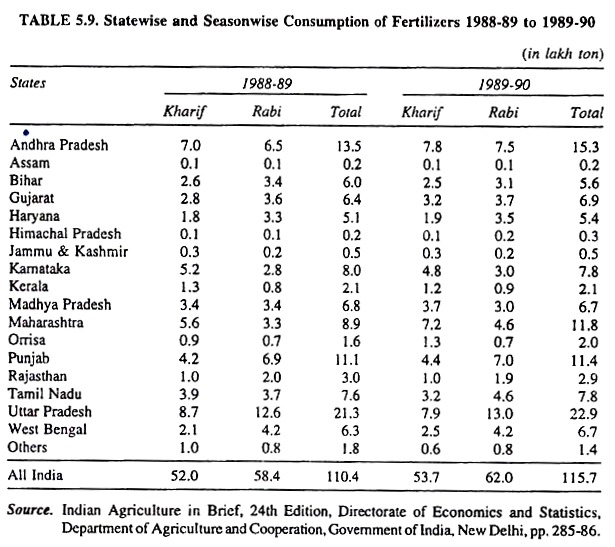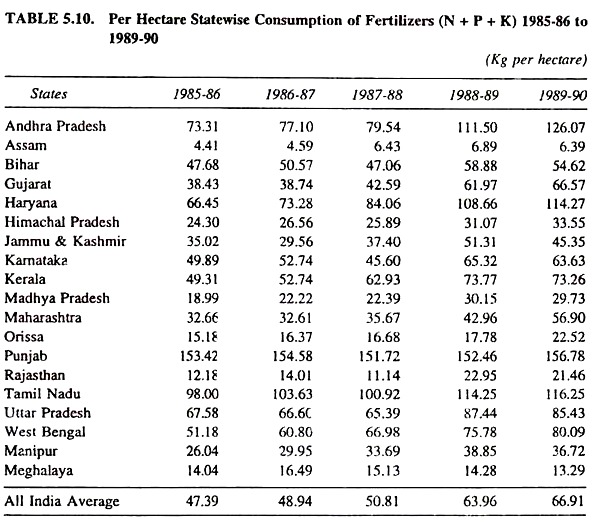This article provides a study note on agronomic practices.
Seed, particularly the new seed, viz., the High Yielding Varieties (HYV) which brought green revolution in the South East Asian countries like India, Bangladesh and Pakistan. The new seed or the HYV demands sound tillage practices, since the yield is much higher than the traditional varieties it demands added cost in harvesting, transportation, storage.
The new seeds are expensive in the initial stages of its introduction but the return is good for those who adopt it first but with increase in demand the returns get reduced as a matter of competition. In striving for economic balance we always run into economic principles, the product and return from a resource depend upon the amount of other resources and practices with which it is combined.
The HYV has revolutionized the agronomic practices known as packages of practice that is, the HYV demands application of high dosages of fertilizers, irrigation, plant protection measures and mechanization of tillage practices for the proper timings of practices.
ADVERTISEMENTS:
Varietal trial should be given to allocate them to different regions suitable to these varieties. The Indian Council of Agricultural Research has conducted these trials under the National Demonstration Schemes in the country.
For the paddy crop Andhra Pradesh, Tamil Nadu, and Punjab were found most suitable, for wheat Punjab and Western Uttar Pradesh, Jowar and Bajra in Rajasthan and Madhya Pradesh, while maize was found suitable for Punjab and Haryana.
Farmers and Farm managers should keep in touch with the Agricultural Universities and Agricultural institutions for further information about new varieties, agronomic practices, yields levels, and economics of their production.
Managers of farms should consider opportunity cost principles for making right decisions for the investment of limited funds. Treatment against diseases, like late blight, smut, rust, red rot of sugarcane.
ADVERTISEMENTS:
If treatment is given where the diseases do not occur then it would be an economic loss. In case the manager fails to adopt prophylactic measures and diseases appear it will result in significant loss and would hurt the economy. With the proper sowing and planting practices the cost per unit of output shall be reduced as the yield per unit of land will be significantly higher.
Time of sowing and planting should be religiously adhered to as there is optimum condition of air, moisture and temperature at the right time which are the requirement of crops. So the right time could be managed with the help of calendar of operation.
On a mechanized farm sowing and planting machinery would be profitable to add in the inventory but its annual use should be kept in mind otherwise custom hiring will be helpful.
This will ensure timely operation. The operator of a large sized farm and larger heads of livestock having competitive demand for the labour and farm machinery should consider the opportunity cost principle and also another principle viz., the added cost and added returns.
ADVERTISEMENTS:
The rates of sowing—this varies from crop to crop. The scientists do recommend certain quantity per hectare which varies from variety to variety. Excessive rate causes diminishing rates of return. Fertilizer quantity and seed rates have interrelationship.
The farm manager should make judgment of the proportion of the two. The best seeding rate will depend on the prices of the fertilizer and the product (yield of crop).
Again, the calculation of the most profitable rate must consider the costs of added fertilizer and added seed in relation to the added yield and its value. In this context the germination rate is also important. The tillage operation as well as is considered on the principles of added cost and added returns.
The rate of application of fertilizer depends on crop variety, moisture content of the soil, seeding rate, application of irrigation and conservation practices.
ADVERTISEMENTS:
The economic principle applied how much fertilizer should be applied are: Cost and Return principles (diminishing return and marginal cost), for farm with limited capital position opportunity cost and substitution principles are used for the combination of fertilizer with organic manure.
The quantity of fertilizer applied depends on management practices, price outlook, capital position and also the amount of other elements. There is no standard rate of application. The economic implication is the rates of return and price of products and the cost of fertilizer. Thus, it is wise to invest when the return is the highest.
The economic evolution of the time and methods of application of fertilizer must consider the following possibilities:
(i) If yields are the same under the two systems, compare the cost of application and select the least cost method;
ADVERTISEMENTS:
(ii) If the two costs are the same select the time and method which gives the greatest yield.
Partial budgeting is resorted to taking into consideration the cost of fertilizer, its application and return from the crop.

